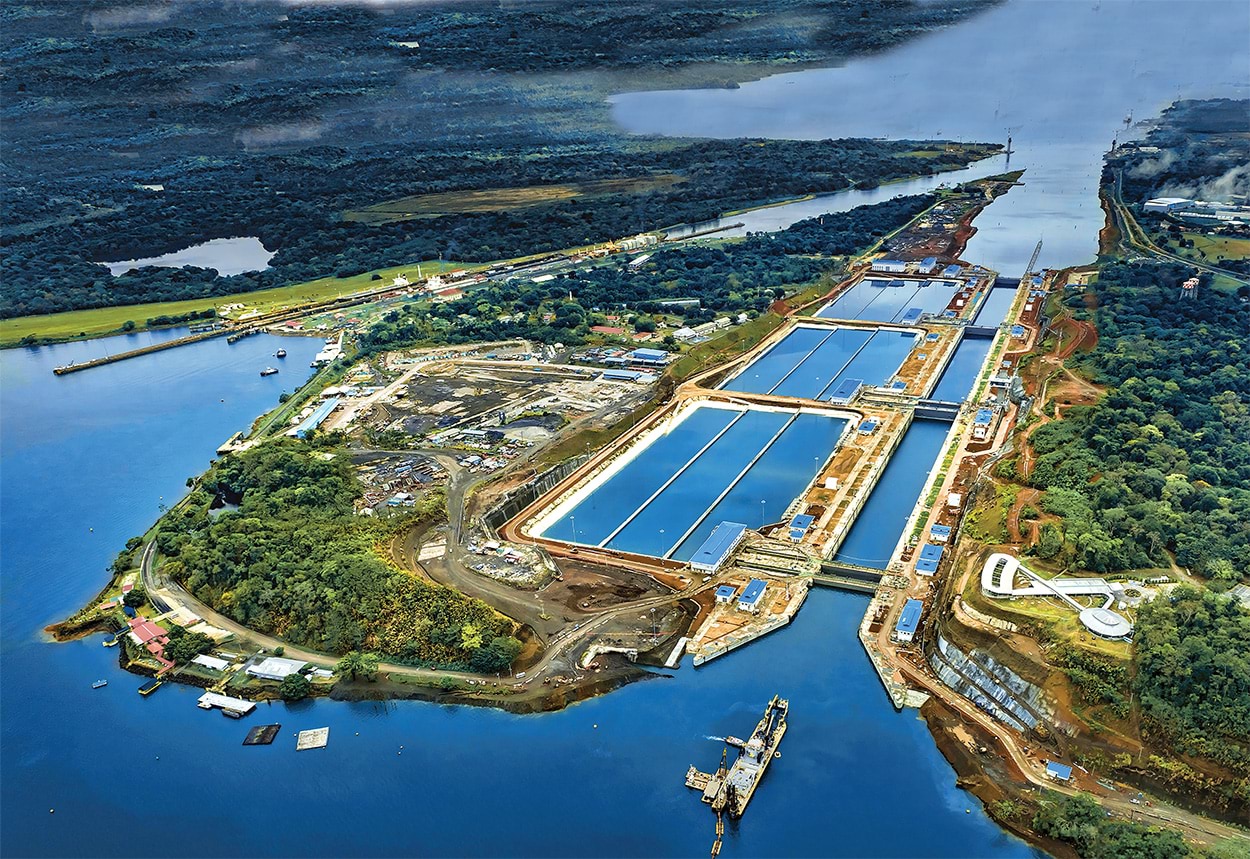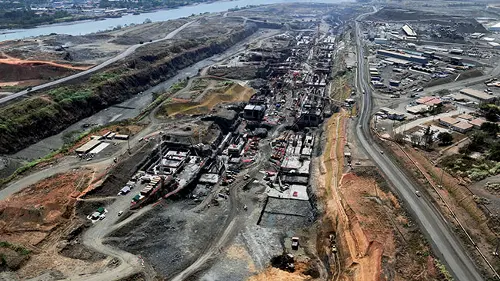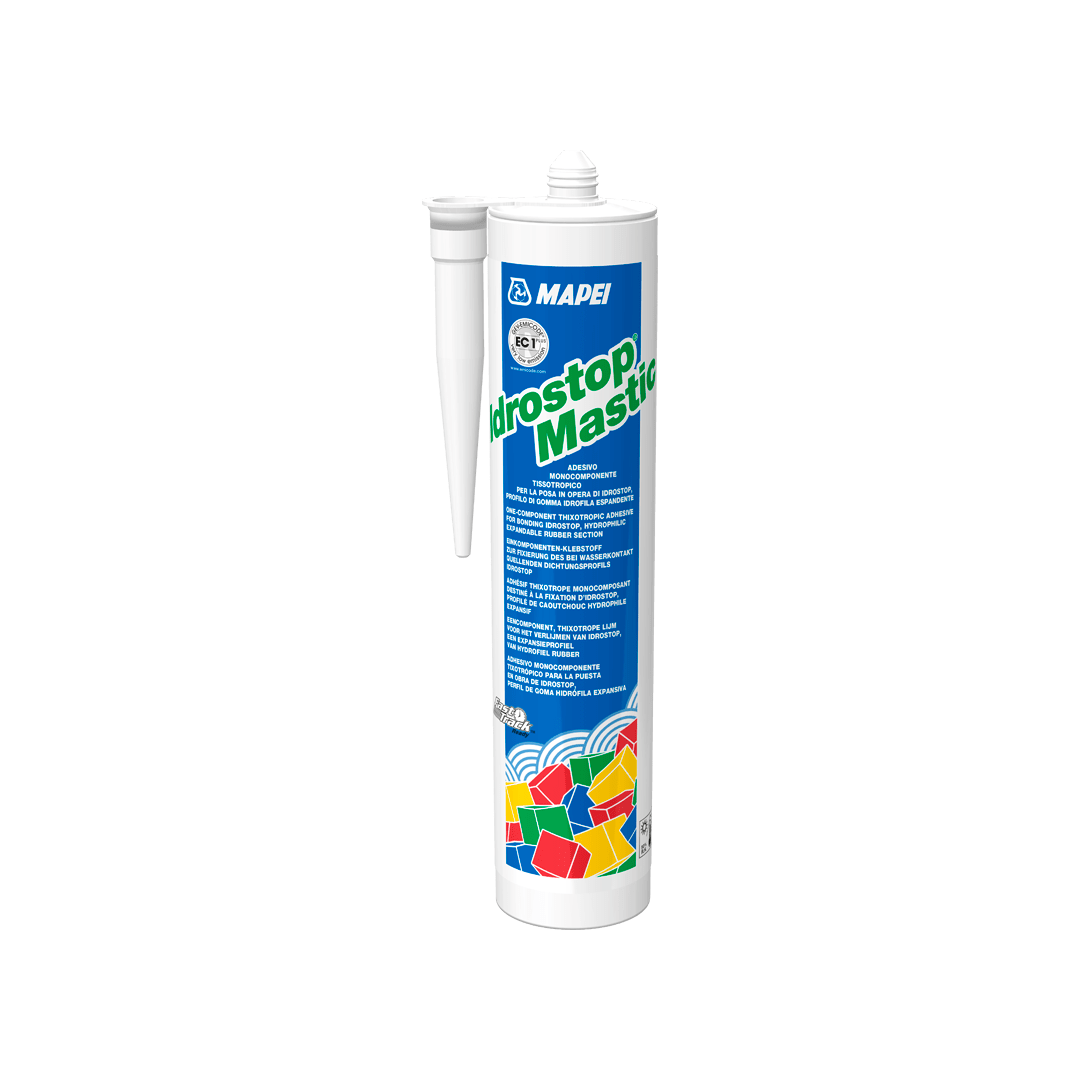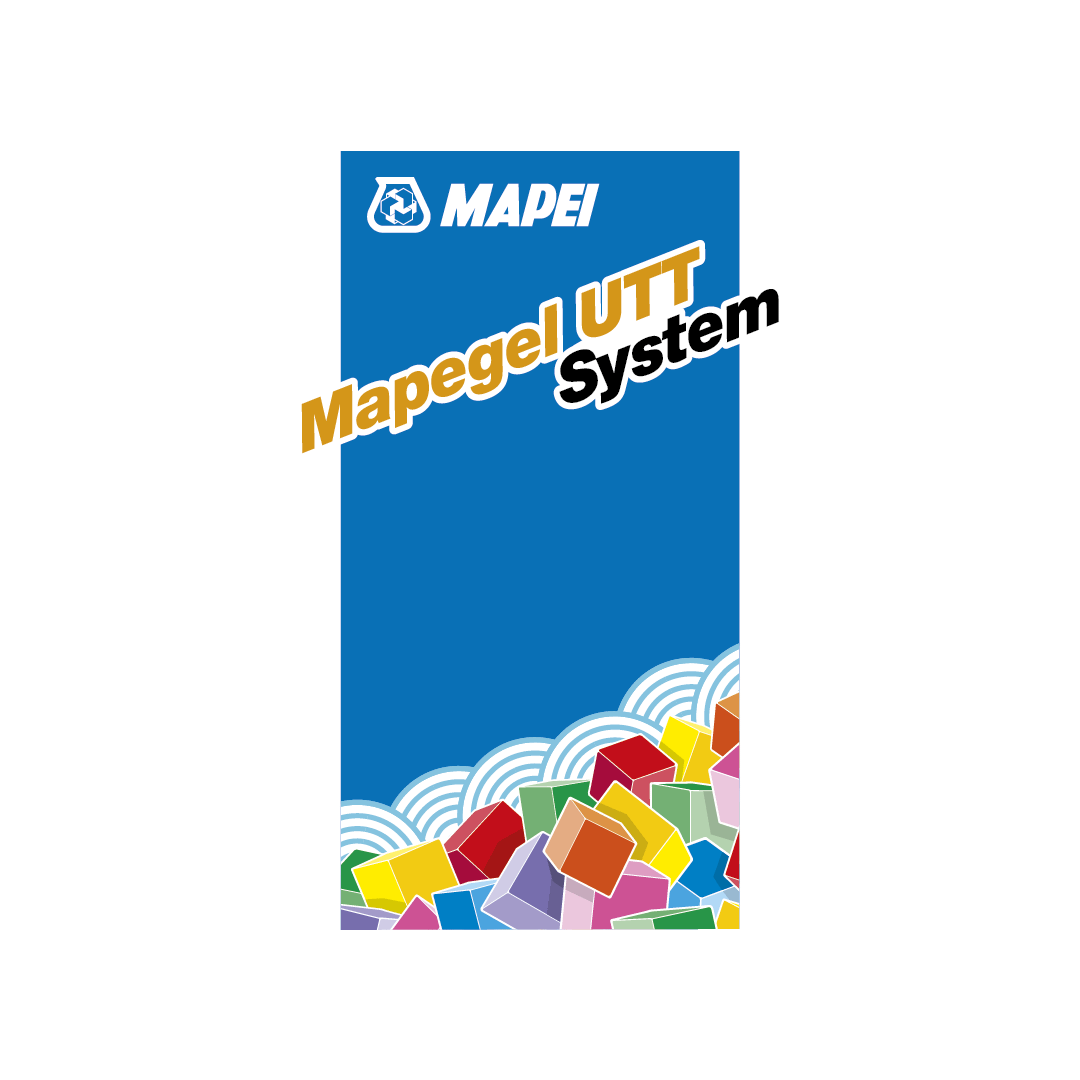
The new Panama Canal
Mapei was amongst the key players of the most ambitious “made in Italy” feat of engineering ever completed in the world.
This article was originally published on July/August 2016 on Realtà Mapei International No. 59.
Mapei was amongst the key players of the most ambitious “made in Italy” feat of engineering ever completed in the world.
26thJUNE 2016: THE NEW CHANNEL OPENS
The first ship to enter from the Atlantic side of the New Panam aCanal was an enormous Chinese container ship (a seafaring giant 300 m long and almost 50 m wide carrying ten thousand containers on board), sailing under a Marshall Islands flag. The Cosco Shipping Panama, which had been renamed specially for the occasion, sounded its siren for more than two minutes when it cut through the entrance ribbon of the new Agua Claralocks at 7:48 on the 26th of June, after which it sailed across the artificial Gatún Lake and arrived in the afternoon, after an eight hour voyage, in front of the VIP stand erected next to the twin locks at Cocoli, on the Pacific side. The President of Panama, Juan Carlos Varela, together with a group of foreign Heads of State and Ministers, was there to welcome this modern merchant vessel, a forerunner of those that will be arriving in the future. Singing, dancing and spectacular fireworks shows were all part of the inauguration party for the 21st century canal, a project that has cost 5.25 billion dollars. It also represents a victory for this small state of just 4 million inhabitants that are throwing down a challenge to the global trade crisis and are looking to put the recent “Panama Papers” scandal behind them as quickly as possible.
Seven years of work, thirty thousand people working on site and a cost of over 5 billion dollars. These are just a few of the figures for the extension work on the Panama Canal, that is,the new locks on the Pacific side and on the Atlantic side that will allow ships with three times the previous capacity to sail through. This is the most ambitious project ever carried out in the world, and not just from an engineering point of view. It is also very much “made in Italy”.
In fact, the bulkheads androlling gates, the technological heart of the entire project, are Italian made by Cimolai, who beat their American competitorsagainst all the odds to upgrade something the Americans hadbuilt at the beginning of the last century. Also Italian made is the operations software and many of the special construction materials, which included bespoke products developed and supplied by Mapei, through consultancy work carried out by the company’s highly skilled technicians and the supply of the latest generation of admixtures for concrete, waterproofing mortars and special products for the structures and to waterproof the storage basins. Italian expertise was also behind the leadership of the international Consortium (GUPC - Grupo Unido Panama Canal) guided by the Italian contractor Salini-Impregilo, which includes the Spanish contractor Sacyr, the Belgians from Jean de Nul and the Panamanian company Constructora Urbana. A little more than two years ago Salini Impregilo, which holds 48% of the construction consortium, just like the Spanish company Sacyr, which also holds 48%, managed to settle a dispute with Panama. “Seven years ago”, commented Pietro Salini, CEO of Salini Impreglio, “We set out on this long journey that represented the synthesis of a dream and a challenge, the sort that every business and every man would like to experience at least once in their lifetime: to build something with the potential to change global commerce.”
NEW MARITIME TRADE
An 80 km long, inter-ocean canal with the capacity to double the yearly return for Panama to up to 5 billion dollars. A revolution in global maritime commerce really is under way. A new type of ship with loads of up to 14,000 containers will be able to pass through the new canal locks, which up until now could only handle ships carrying 4,400. Half the arsenals from around the world have changed in order to construct them, while the Pacific and Atlantic ports, particularly in the United States, have already carried out large-scale interventions in order to handle these new ships, generating spin-off activities worth twenty times the cost of the work, equating to more than 100 billion dollars.
The first area to benefit from the expansion project has been the east coast of North America because it will now be reached via a direct route across the Pacific from Asia, rather than the longer route across the Mediterranean and Atlantic, which means two weeks less navigation time.
And Italy could also reap the benefits if one knows how toact and react. In fact, expansion of the Panama Canal coincides with the expansion work on the Suez Canal which could turn the Mediterranean into the centre point for many trader routes. 19% of the volume of global traffic and 25% for global routes currently transit through the Mediterranean Sea. Italy is the third most important nation in Europe for goods traffic with 473 million tonnes and is the leading nation amongst EU countries for short range trade. In twenty years the number of containers handled in the 30 most important ports in the Mediterranean has grown by 425%, at an annual rate of growth of 21%. But something new is needed, both from port authorities and from the ports themselves. The ports of Gioia Tauro (Southern Italy) and Genoa (Northern Italy) handle more than two million containers, but this figure is quite a way behind their direct competitors in Valencia and Algeciras (Spain), and Port Said (Egypt).
THE TECHNICAL ASPECTS AND FUTURE OF THE CANAL
The chambers of the new locks system are 427 m long, 55 m wide and 33 m deep. They act like giant lifts that raise the ships 27 m above the level of the ocean to the level of the artificial Lake Gatún and the navigable route that crosses the Isthmus of Panama, to be then lowered down again on the opposite side, ready to set off on their oceanic voyage. Next to each chamber the Consortium has built enormous storage basins where the water is recycled: they allow more than 60% of this precious resource to be saved, and then feed it back into the locks system. The “old” Canal, built by the Americans at the beginning of the last century, and which today still gives a return of 2.5 billion dollars, will continue to operate. The Panamanian authorities have already received more than 166 bookings between now and December. Estimates foresee that income from the Canal will double to 5 billion dollars a year once the new Canal has become fully operational.
The main client is still the United States, who on the 31st of December 1999 handed over administration of this precious waterway to Panama. But the Chinese are fighting back with their increasingly large merchant ships. So much so that the Canal authorities are already working on a future plan and are analysing the costs and benefits of a fourth route, maybe even larger than the current one.
HEAD-SPINNING FIGURES
The construction of the new canal required an enormous building site with head-spinning figures: 70 million cubic metres excavated, 290,000 tonnes of steel, 5.5 million cubic metres of concrete and more than 100 million hours of work. The jewel in the crown of the project are the 16 giant steel gates, built in Italy and transported via sea over the courseof seven years. The average weight of each gate is 3,000 tonnes and they carry out their task in just five minutes: to open and close the water chambers which – operating like enormous lifts – allow he ships to overcome the 27 m difference in level between the two oceans and the artificial Lake Gatún.
MAPEI KNOWHOW
Through their subsidiary company Mapei Construction Chemicals Panama S.A., Mapei supplied various admixtures of the latest generation to manufacture around 5,500,000 m3 of mass concrete and marine concrete, used respectively to build the internal and external sides of the locks.
DYNAMON XP2 and DYNAMON XP2 EVOLUTION 1 were developed specifically to build the new Canal (see Realtà Mapei International no. 40, 42, and 46). After numerous checks, carried out in the purpose-built Mapeilaboratory in Panama, and cross-referencing the results with the GUPC laboratory, DYNAMON XP2 was chosen for use during the first six months of work on the project on both the Atlantic side, where they were using Panama cement, and on the Pacific side, where they were using Cemex cement.
The objective was to guarantee a service life of the work of 100 years, thanks to the use of a model that calculates the durability of concrete. After commissioning the plants producing the concrete and aggregates, several serious problems regarding a considerable loss of mechanical strength and durability in the concrete produced by the plants were solved. In this phase, Mapei’s support focused on various activities: a study and chemical and mineralogical analysis of the rawmaterials used (basalt aggregates, pozzolan and cement); technical suggestions for the correct choice in flocculants and coagulants employed to treat the waters used to clean the aggregates so that they would be more chemically compatible with the super-plasticisers used in the concrete mix; chemical and petrographic analysis; control of the pozzolanic activity of the basaltic fines from the cleaning operations to assess its use in the concrete mix and optimise its natural pozzolan content.
Following a request from the client, Mapei then started to develop a new product which could work well with the new mixdesigns being verified at the GUPC laboratory. Mapei technicians designed the formulation for a new admixture called DYNAMON XP2 EVOLUTION 1, with the name chosen to give a sense of continuity to the enormous amount of work previously carried out on the old admixture. This product proved to be even better at maintaining the workability and placing of the concrete at even lower dosage rates compared with the competitors’ products.
RENOVATING THE EXISTING CANAL
The project also included renovation work on the original Canal. Mapei offered their contribution to help repair and consolidate the foundations for the Gatún Lock, located approximately 30 m below ground and considered to be the most imposing reinforced concrete structure ever built. This building site used a particular type of mortar and to make it Mapei supplied PLANITOP 15, an one-component shrinkage compensated cementitious mortar ideal for form-and-pour and form-and-pump applications (which is manufactured in theUSA by Mapei Corp.), and MAPECURE SRA, a special curing admixture for cementitious mortars and concrete to reduce hydraulic shrinkage and the formation of micro-cracks.
SYNTHETIC WATE RPROOFING MEMBRANES
For the third set of locks – which completed the expansion work on the Canal - an environmentally and socially sustainable project was drawn up, called the Water Saving Basins project, to limit its impact on the surrounding area, the people and the environment. In so doing, 60% less water will be required: whereas normally each passage requires around 500 million litres of water, the new system will only need 200 million litres.
Mapei contributed to this work with the synthetic membranes SIBELON PVC-P. SYBELON trademark is owned by CarpiTech Sibelon. Manufactured at the Polyglass (Mapei Group) plants,the membranes were used to waterproof the auxiliary basins that recover and partially recycle the water from Lake Gatún. Developed specifically for hydraulic works, SIBELON PVC-P synthetic membranes, laminated to non-woven polypropylenefabric, were applied over a total surface area of around 800,000 m2. Characterised by their high resistance to UV rays and aggressive atmospheric agents, they guarantee a high level of durability over the years.
Mapei supplied numerous other products for completing this grandiose project, such as PLANIGROUT 300, MAPEGROUT 05/06, IDROSTOP PVC BI/BE, IDROSTOP MULTI, MAPEGEL UTT, IDROSILEX PRONTO, MAPEPROOF SWELL, IDROSTOP 10 and IDROSTOP MASTIC.














.jpg?sfvrsn=337a0674_4)


b3bf647979c562e49128ff01007028e9.jpg?sfvrsn=357a0674_4)
.jpg?sfvrsn=307a0674_2)
.jpg?sfvrsn=347a0674_2)




